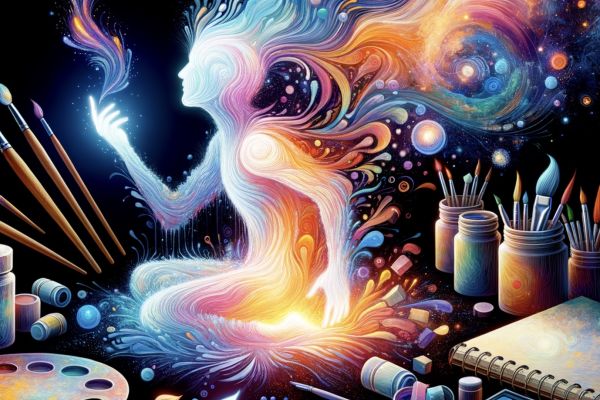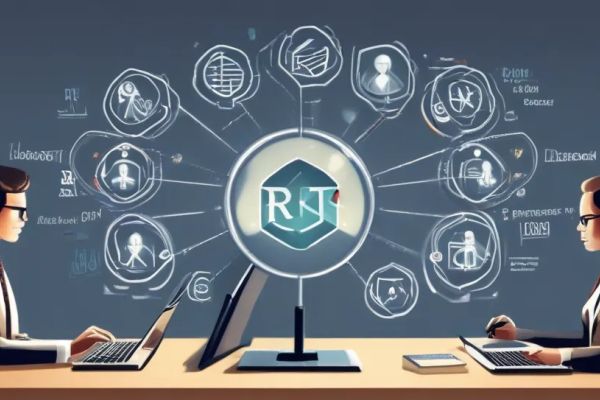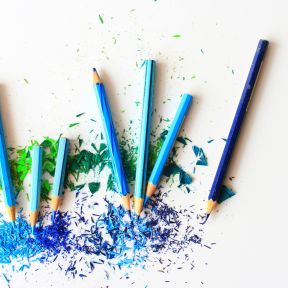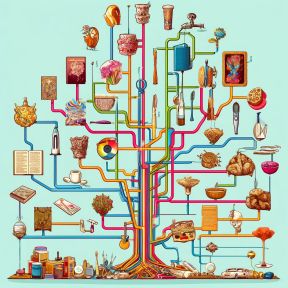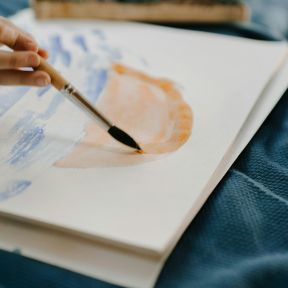
Creativity
Creativity encompasses the ability to discover new and original ideas, connections, and solutions to problems. It’s a part of our drive as humans—fostering resilience, sparking joy, and providing opportunities for self-actualization.
An act of creativity can be grand and inspiring, such as crafting a beautiful painting or designing an innovative company. But an idea need not be artistic or world-changing to count as creative. Life requires daily acts of ingenuity and novel workarounds; in this sense, almost everyone possesses some amount of creativity.
Contents

There are many pieces to the puzzle of creativity, including a balance between controlled, deliberate thought and spontaneous play and imagination. Personality plays a role, as well as biology and life experience.
But everyone possesses some measure of creativity, even if they don’t realize it. Life is full of small moments that require new ideas or surprising solutions. A choice that you don’t think twice about—how you cook a fried egg or the route you take to work—someone else might find delightfully original.
Creative people embody complexity; they show tendencies of thought and action that are segregated in others, according to the pioneering creativity researcher Mihaly Csikszentmihalyi. They balance intense energy with quiet rest, playfulness with discipline, fantasy with reality, and passion for their work with objectivity.
Neuroscience research seems to support this idea. Creative people may better engage the three brain systems—the default mode network, the salience network, and the executive control network—that collectively produce creative thought.
The trait of Openness to Experience correlates with creativity, encompassing a receptivity to new ideas and experiences. People who are low in openness prefer routines and familiarity, while those who are high in openness revel in novelty, whether that is meeting new people, processing different emotions, or traveling to exotic destinations. Accumulating these experiences and perspectives can help the brain forge creative new connections. Other characteristics that are linked to creativity include curiosity, positivity, energy, persistence, and intrinsic motivation.
When we think of creativity, we often think of Mozart, Picasso, Einstein—people with a seemingly fated convergence of talent and opportunity. It's too narrow a set of references, because all sorts of people, possessing various levels of intelligence and natural ability, are capable of engaging in fulfilling creative processes. And buying into a limited definition of creativity prevents many from appreciating their own potential.
Everyday creativity is a framework originally developed by Ruth Richards, Dennis Kinney, and colleagues at Harvard Medical School defined as expressions of originality and meaningfulness. This could encompass daily errands, personal hobbies, or work. Making wacky recipes or dying your hair an unusual color would qualify, as would working on a scrapbook of memories for a friend.
People sometimes refer to “little-c” or “Big-C” to discuss different degrees of creativity. This framework was expanded into a theory called The Four C Model of Creativity by researchers James Kaufman, Ronald Beghetto. Mini-c refers to creativity that arises in any learning process and little-c refers to consistent everyday creativity. Pro-c is the progression to professional expertise in a given domain, while Big-C is reserved for monumental and historic contributions to society.

Many people feel that they have no or very limited creative ability—even some who work in creative fields—and it's true that certain individuals are more creative than others. Fortunately, however, creativity can be acquired and honed at any age or experience level.
Innovation is not some divine gift; it’s actually the skilled application of knowledge in new and exciting ways. It requires changing up your normal routine, stepping outside of typical comfort zones, and paying attention to the present moment.
When learning new information, taking a break—either by sleeping or simply enjoying a distraction—is another way of allowing the unconscious mind to process the data in novel and surprising ways. This often lays the groundwork for a creative insight or breakthrough.
Various lines of research have converged around common insights that provide steps to be more creative:
1. Aim for output: Creative geniuses often produce their best works at their times of greatest output. Some pieces may miss the mark, but the quantity of output makes it likely that other pieces will yield great creativity.
2. Be willing to go deep: In the realm of artistic creativity, pioneers often spend time in solitude, feel emotions and sensations deeply, and aren’t afraid to self-reflect.
3. Be open and playful: The personality trait most tied to creativity is Openness to Experience—whether that be intellectual, aesthetic, or emotional.
4. Capture your ideas: Remember to record thoughts as they arise so they aren't forgotten.
5. Adopt or hire outside perspectives: It can be difficult to innovate if you become trapped in the rules and language of your domain of expertise.
6. Feel free to procrastinate: If you are motivated to solve a problem, procrastinating, exercising, or sleeping on it can lead to divergent thinking and more possibilities.
Most of the time, ideas develop from the steady percolation and evaluation of thoughts and feelings. But every so often, a blockbuster notion breaks through in a flash of insight that’s as unexpected as it is blazingly clear. So-called “aha moments” can generate the brilliant idea for a tech startup, the theme of a musical composition, or the answer to an engineering quandary.
Improving the odds of having a “eureka moment” involves toggling between two modes of thinking: conscious, methodological, concerted problem solving and the restful, spontaneous, unplanned connections of the default mode network, the brain’s resting state. In this way, the default mode network can inspire new solutions when all of the puzzle pieces are in place.
Studies show that training can lead both children and adults to hone creative skills. Sessions may focus on identifying problems to solve, exploring different possibilities, and enhancing emotional intelligence. In one training, for example, instead of making art immediately, children were asked to play with materials—feel their textures, try them out, arrange and rearrange them. Children were encouraged to use emotion-laden memories to explore ideas for art portraying different emotional themes—what colors or textures could be associated with anger?
Several strategies can help build your creative muscle. One is to find a problem that needs solving, and another is to be open to new opportunities, such as trying new foods or using a new approach to complete a task at work. Another is to change your perspective, such as by imagining what somebody else or somebody in a different time period might think. Yet another is to simply create—creativity requires risk-taking and critical feedback, but persisting through discomfort can lead to an innovative and daring outcome.
Creativity may offer some surprising psychological benefits. It can contribute to the ability to make meaning—such as finding ways to successfully cope with past experiences such as trauma, regret, or nostalgia, helping to manage moods, relationships, and problem-solving, and establishing one’s professional and personal legacy for the future. Well-being, in turn, may facilitate creative thinking, such as by practicing mindfulness, research suggests.

Creative thinking involves making new connections between different ideas, which is accomplished by cultivating divergent thinking skills and deliberately exposing yourself to new experiences and to learning. While research psychologists are interested in tapping innovative thinking, clinical psychologists sometimes encourage patients to use artistic expression as a way to confront difficult feelings.
Three key networks operate as a team to spark creativity in the brain, research suggests. The default mode network helps generate ideas, the executive control network evaluates them and propels them forward, and the salience network identifies which ideas are relevant and important. These networks may also influence one another via other feedback loops; for instance, the executive control network might tune the way the salience network scans internally, depending on the task at hand.
The default mode network is the pattern of brain activity that occurs when people are not focused on the outside world. It’s the network that becomes active when the mind turns inward, as people daydream, rest, and reflect on the past or imagine the future. The default mode network can spark connections between different ideas, contributing to creative thought.
The salience network is a large system within the brain that helps to detect and filter important information from the environment, and then determine how to respond to that information. It scans for relevant signals, whether they contain sensory, cognitive, or emotional information. The salience network is rooted in the anterior insula and dorsal anterior cingulate cortex, but it contains nodes in other regions as well.
The executive control network, or executive function, refers to the systems and processes that allow people to plan, monitor, and execute their goals. In the context of creativity, executive functioning monitors the observations, connections, and ideas that are generated, directs attention to particular ideas, and oversees decision-making in the context of a larger goal.
A hallmark of creativity, divergent thinking involves generating multiple ideas or solutions to a problem. It’s original and imaginative, exploring as many different connections as possible. By contrast, convergent thinking is converging onto a single, correct answer or solution, by analyzing the information available and judging which answer is best.
The belief that the left hemisphere completely controls logic and the right brain governs creativity is largely a myth. Creativity and imagination involve communication between networks throughout both hemispheres, research shows. Those networks work together and collectively manipulate ideas, images, and symbols.

From Vincent van Gogh to Sylvia Plath and Winston Churchill, individuals with mental illness have unleashed intellectual and artistic genius throughout history. The connection has fascinated psychologists and everyday individuals alike. What biological theories might explain the overlap? And what evolutionary advantages might these individuals possess?
Psychotic spectrum disorders, including bipolar disorder, schizotypy, and schizophrenia, are disproportionately diagnosed in highly creative individuals (they've been most often measured in artists, musicians, and writers) or in their first-degree relatives.
But this connection can be confounded by the degree of giftedness at play. While creative types are more mentally stable than are non-creatives, the correlation reverses in the presence of exceptional creativity. Extraordinarily creative individuals are more likely to exhibit psychopathology than are noncreative people, according to University of California at Davis psychologist Dean Keith Simonton. He dubs this concept the "Mad Genius Paradox."
An inability to filter out seemingly irrelevant information is a hallmark of both creative ideation and disordered thought. The state, known as reduced latent inhibition, allows more information to reach awareness, which can in turn foster associations between unrelated concepts. The barrage accounts for both the nonsensical ideas seen in psychosis and for novel thinking.
One hypothesis for the mystery between genius and mental illness is rooted in the diametric theory, an idea put forth by sociologist Christopher Badcock and evolutionary biologist Bernard Crespi to explain how autism and schizophrenia are poles on one cognitive continuum. (In this theory, paternal gene expression pushes towards mechanistic thinking—autism at its most extreme—and maternal genes produce mentalizing traits—psychosis at its most extreme.)
The theory makes a key prediction—that epoch-making minds, likely including John Nash's and Isaac Newton's, exhibit both hypermechanistic and hypermentalizing extremes. These men were both autistic and schizophrenic—double outliers. True genius in some realms, especially mathematics and science, could represent that unique overlap.
Some research has found that genetic variants that are more common in schizophrenia and bipolar disorder are also more common in certain creative professions. However, it’s difficult to conduct reliable studies of the link between genetics and a broad trait like creativity. What we do know, however, is that many mental health conditions, including schizophrenia and bipolar disorder, have a genetic component, so the condition and potentially related traits are passed down from one generation to the next.
Bipolar disorder and schizophrenia can be debilitating illnesses, so scientists have wondered why these conditions have persisted over time. Some believe that schizophrenia and bipolar disorder offer an evolutionary advantage, in that they predispose individuals to greater creativity, achievement, and success that can benefit both individuals and societies.
People with bipolar disorder can be deeply concerned that medication will strip away the creativity and productivity that accompany manic episodes. Therefore it’s important to address the topic in therapy.
Therapists should explain that manic energy can be confused for creative skill; mania often deludes individuals into believing they are greater than their skills. The pair can discuss the patient’s innate talents and skills to develop, and then devise a strategy to do so following mood stabilization, continuing to adapt to new circumstances or challenges as they arise.

Creativity is typically seen as a socially beneficial trait. But some people use their imagination in pursuit of antisocial ends—what's sometimes termed “dark creativity” or “malevolent creativity.”
A scam artist who devises a novel or foolproof scheme for luring his victims is exercising creativity. But as it’s being deployed to harm others and enrich himself, most observers would find his scheme objectionable, no matter how imaginative.
In recent years, researchers have sought a greater understanding of how darkness and creativity interrelate. Some studies have found that creativity is associated with narcissism; others have identified a link between higher creativity and reduced honesty and humility. In one study, dispositional creativity was found to predict unethical behavior.
Ultimately, creativity may be better conceived as neither inherently positive nor inherently negative. Instead, it may be best to assess motivations and outcomes when judging the value of any creative act.
One distinction between light and dark creativity involves who benefits and who stands to be harmed by the creative pursuit. Light creativity is associated with ways to benefit others in society, or at least not detract from their welfare, such as composing a moving symphony or founding a tech start-up. Dark creativity is primarily associated with harming others or helping oneself without caring about the potential for collateral damage—devising an elaborate plot to rob a store, for example.
Malevolent creativity has been linked to childhood experiences, such as neglect, and traits in the dark triad, such as narcissism. Another characteristic linked to dark creativity is aggression. In one study, premeditation (planning ahead of time) controlled an individual’s expression of malevolent creativity more than implicit aggression—in other words, being able to hold off on your impulses can make even those primed to be aggressive and darkly creative less harmful when provoked.
Some argue that creativity exists on a spectrum and creative pursuits can exist in the gray area between light and dark. For example, if someone comes up with a clever white lie to avoid meeting someone, that original and plausible idea might lean toward a darker use of creative thinking. The grayer areas of creativity arise when it’s not completely clear where the eventual benefit of the creative behavior lies. For example, is hacktivism bright creativity or dark?

